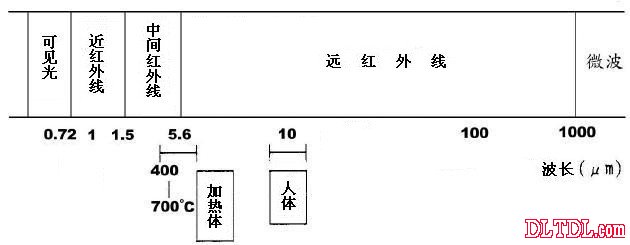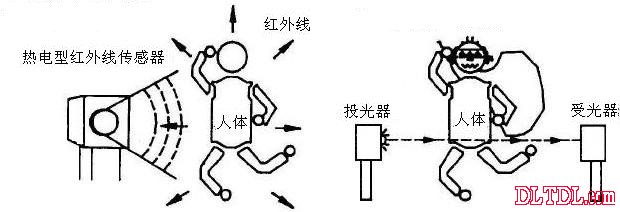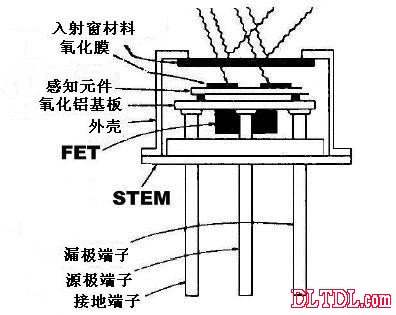Infrared sensors can be divided into actions according to their actions:
(1) Convert part of the infrared light into heat, and take out the heat type of the output signal such as the resistance value change and the electromotive force by heat.
(2) The photoelectric effect of absorbing energy difference by semiconductor migration phenomenon and the quantum type utilizing the effect of photoelectromotive force due to PN junction.
The hot type phenomenon is commonly called the pyroelectric effect, and the most representative ones are Thermal Bolometer, Thermopilile and Pyroelectric components. The general characteristics of the heat type and the quantum type are shown in Table 1, and only the heat type pyroelectric type infrared sensor will be described here.
advantage
Disadvantage
Hot type
Normal temperature action
Wavelength dependence (wavelength is different
There is a big change in sensitivity)
Does not exist
Cheap
Low sensitivity
Slow response (mS spectrum)
Quantum type
High sensitivity
Fast response (μS spectrum)
Must be cooled (liquid nitrogen)
Wavelength dependence
High price
Table 1 Comparison of infrared heat type and quantum type
In particular, the sensor uses the sensitivity of the far-infrared range as the human body detection. As shown in FIG. 1, the wavelength of the infrared light is longer than the visible light and shorter than the electric wave. Infrared light makes people feel that it is only emitted by hot objects, but in fact it is not. Any objects that exist in nature, such as humans, fire, ice, etc., all emit infrared rays, but their wavelengths are different due to the temperature of their objects. . For example, in Fig. 1, the body temperature of the human body is about 36 to 37 ° C, and far infrared rays having a peak value of 9 to 10 μm are emitted, and an object heated to 400 to 700 ° C can emit intermediate infrared rays having a peak value of 3 to 5 μm.

Figure 1 Differences in temperature at different infrared wavelengths
The infrared sensor is a sensor that detects various infrared (temperature) emitted by these objects.
feature
The pyroelectric type infrared sensor utilizes a thermoelectric effect, and the material thereof is a single crystal such as a dielectric ceramic body (Lielectric Ceramic), a lithium niobate (LiTaO3), or an organic material such as PVDF.
Thermoelectric infrared sensors have the following characteristics:
(1) Since the infrared rays emitted from the object are detected, the temperature of the surface of the object can be sensed without direct contact, so that the temperature of the human body and the moving object can of course be measured in a non-contact manner.
(2) The pyroelectric infrared sensor receives the infrared ray emitted from the object to be detected, so it is passive (please refer to Fig. 2(a)). Since it is not the active type shown in (b), it does not need to calibrate the emitter. The cumbersome work of the optical axis of the light receiver.

(a) passive type (b) active type
Figure 2 method of human detection
(3) The thermoelectric effect is caused by a change in temperature, which will be described later, so that only the energy due to temperature change (Energy) is accepted, and the pyroelectric type infrared sensor differentiates the voltage and outputs it.
principle
First, the thermoelectric effect is introduced. As shown in Fig. 3, the sensing component uses a PZT (lead titanate zirconate ceramic body) strong dielectric ceramic body, and a high voltage power is applied to the sensing component (3KV to 5KV/mm).
In this way, the positive and negative charges appearing on the surface of the component are electrically neutralized by the opposite charge in the air, as shown in Figure 2-24. When the surface temperature of the component changes,
The size of the sensing component's poles changes with temperature, so the state of charge neutralization collapses when it is stable, and the surface charge of the sensing component is different from the relaxation time of the absorbing stray charge, so an electrical imbalance is formed. An unpaired charge is generated, as shown in Figure 3(b).
The phenomenon of generating electric charge due to temperature change is called thermoelectric effect. If the generated charge is Δθ and the temperature change is ΔT, then Δθ/ΔT=λ (Coulomb/°C) is the thermoelectricity.
coefficient. In fact, how does the actual sensor use the thermoelectric effect? ​​Please refer to the internal structure of the sensor and the explanation of this article. Figure 4 shows the structure of the pyroelectric infrared sensor.

(a) When stable (T)K (b) After the temperature has just changed (T+ΔT)K
Figure 3 Principle of the pyroelectric infrared sensor

Figure 4 Internal structure of the pyroelectric infrared sensor
(1) Infrared rays of various wavelengths are injected into the sensor.
(2) The entrance window at the top of the module is covered with a filter, allowing only the necessary infrared rays to pass through, and isolating unwanted infrared rays.
(3) The heat absorbing film located on the surface of the sensing component converts infrared light into heat.
(4) The surface temperature of the sensing component rises, and the surface charge is generated due to the thermoelectric effect.
(5) The generated surface charge is amplified by the FET and the impedance is changed.
(6) Supply the voltage required for the FET operation from the drain (Drain).
(7) The amplified electrical signal will appear on the externally connected source-ground resistance and will be removed after overlapping with the bias voltage.
application:
(1) Can be used as an Intrusion detector.
(2) Motion detection.
(3) Automatic light control.
(4) Automatic door control.
characteristic:
project
Minimum typical maximum unit test condition
Inspection type
Two-component type
response
2300 2800 3300 V/W
8~14μm/1Hz
noise
25°C/.3~10Hz
Drift voltage
0.2 0.6 1.5 V
Rs=47KΩ
Output impedance
10 KΩ
Operating temperature
-40~70 °C
ΔT<5°C/min
Operating voltage
3 15 V
DC
Operating current
4 20 50 μA
Use attention
(1) When using a heat collecting component such as CMOS, prevent static components from damaging the component.
(2) Avoid use in places where the temperature is improved above 3 °C/min (3 °C/minute).
(3) Only avoid touching the sensor's detection wall with a finger. If necessary, wipe it with cotton and alcohol.
Application circuit: human body Joule body temperature sensing

The Joule type body temperature sensor has a high output impedance due to electrostatic effects. Therefore, one side of the substrate is connected to a FET as an impedance matching voltage follower, and DC is required to be applied to the D and S poles.
When the human body approaches the sensor, a pulse signal is sensed at the source (S) terminal and sent to the operational amplifier to make a forward amplifier. Adjust the VR1MΩ to change the magnification of the output.
Pod Mod,Closed Pod Systems,Vape Pod,Pod Vape Kit
Shenzhen Xcool Vapor Technology Co.,Ltd , http://www.xcoolvapor.com